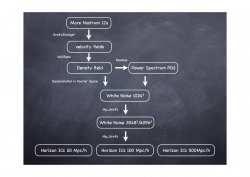
The site's hierarchy
Science
/
Conditions Initiales
/
Conditions initiales cosmologiques
/
ICs Data
/
Horizon-WMAP I
/ Production Pipeline
Navigation
Mar 2009
| M | T | W | T | F | S | S |
|---|---|---|---|---|---|---|
| 23 | 24 | 25 | 26 | 27 | 28 | 1 |
| 2 | 3 | 4 | 5 | 6 | 7 | 8 |
| 9 | 10 | 11 | 12 | 13 | 14 | 15 |
| 16 | 17 | 18 | 19 | 20 | 21 | 22 |
| 23 | 24 | 25 | 26 | 27 | 28 | 29 |
| 30 | 31 | 1 | 2 | 3 | 4 | 5 |
- Les premiers zoom de galaxies sont accessibles
- Le halo FOF 6133 de la boite Horizon L et le halo FOF 544 de Horizon S ont été resimulés avec plusieurs techniques de zoom. Il est important que chaque "zoomer" valide sa méthode, avant de lancer une campagne de zoom sur un plus grand cataloque.
- Les données de la simulation Mare Nostrum sont disponibles
- 34 snapshots jusqu’à z=4 sont accessibles sur horizon3 et sur le serveur de fichiers de l’IDRIS à la collaboration Horizon.
- Méso Machine HPC1 opérationnelle
- Depuis le 23 Octobre 2005, la Méso machine du site horizon est operationnelle. Elle correspond à 3 quadriprocesseurs avec chacun 64 Giga de RAM reliés par infiniband, ainsi qu’un access conséquent (sur une base de projet dédié) au reste de la ferme). Son acces est ouvert a toute personne de la collaboration ayant acces à la minigrille et qui en fait la demande a admin-minigrille
- http://
- Workshop Horizon le 14 et 15 novembre 2005
- Il aura lieu à Paris les 14 et 15 novembre 2005 (prévoir une nuit sur place). L’enregistrement est ouvert dans la rubrique "meeting!"
- http://
Production Pipeline
by Aubert Dominique
(Tuesday 23 May 2006)
The Horizon Cosmological ICs were produced from existing ICs provided by S. Gottloeber (AIP Potsdam) and G. Yepes (UAM Madrid). These "Mare Nostrum" ICs consisted in 1024x1024x1024 particles GADGET snapshots for a 50 Mpc/h box. These ICs are a low resolution version of a previous set of 2048^3 particles ICS, unavailable by now. The whole procedure is summarized in the above flow chart.
Conversion & White Noise Extraction
- The Conversion stage was a two-steps procedure. First the initial velocity field was extracted from the gadget snapshots. Knowing the velocities, the density can be computed following
 . The divergence was computed in Fourier space using the smooth.f90 code. At this stage, the "Mare Nostrum" ICs were converted to the GRAFIC format.
. The divergence was computed in Fourier space using the smooth.f90 code. At this stage, the "Mare Nostrum" ICs were converted to the GRAFIC format.
- The power spectrum P(k) was measured using powmes.f90. An appropriate fitting formula has been found by applying a 2048^3 Hanning filter to the underlying theoretical power spectrum. These ICs also exhibited an excess of power at high frequency, due to the original degradation procedure. This was taken in account by making the fitting formula equal to a smoothed version of the measured P(k) at this frequencies.
- Knowing the underlying power spectrum, the white noise is extracted form the density field by deconvolution. In Fourier space, this procedure is equivalent to a division of the density
 by
by  . This division leads to a white noise in Fourier space for
. This division leads to a white noise in Fourier space for  , which contains the phase of the "Mare Nostrum" ICs. Higher frequencies were filled with a white noise with the same amplitude. This last stage, performed by Mp_grafic, led to the Horizon 2048^3/4096^3 white noise.
, which contains the phase of the "Mare Nostrum" ICs. Higher frequencies were filled with a white noise with the same amplitude. This last stage, performed by Mp_grafic, led to the Horizon 2048^3/4096^3 white noise.
ICs generation
- The ICs generation procedure is the exact converse to the white noise extraction procedure. Three box size (20, 100,500 Mpc/h) were chosen and correspond to three "different" power spectra. The convolution of the Horizon white noise by these spectra results in 3 sets of initial conditions, with different sizes but with the same overall structure.
- In practice, the ICs were produced through Mp_grafic using the Eisenstein & Hu prescription on the power spectrum. The production has been performed in a parallel fashion on the Horizon’s meso-machine.
- Low resolution versions of the ICs were also produced using the degrad_grafic.f90 code. They were produced by averaging the different fields over 2x2x2=8 cells, leading to a hierarchy of 512^3, 256^3, 128^3, 64^4, 32^3 ICs boxes.

